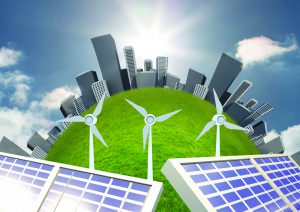BLOOMBERGÂ
If the world is to reach net zero emissions by mid-century, we will need to install several times more wind turbines and solar panels than we are adding today, as well as many times more batteries, hydrogen electrolysers and heat pumps. That requires manufacturing them first.
A new analysis from the International Energy Agency (IEA) shows the current industrial picture for clean energy. It updates the agency’s latest report on energy technology after only a few months, and for good reason: Clean-tech manufacturing is expanding so fast that solar and battery manufacturing capacity are now on track to meet the 2030 milestones set out in the IEA’s scenario for net zero CO2 emissions by 2050.
The report details the industrial characteristics of different technologies. You might group them according to two variables. The first is their relative scale in 2021. Two years ago, the existing capacity for making solar, wind and heat-pump technology could have provided about a quarter of the equipment needed to be on track for net zero, as per the IEA. But that same year, the capacity for making batteries and hydrogen electrolysers was far below what a net zero pathway would require.
The second variable is the speed with which capacity has expanded since 2021. Solar has grown the most. It was already up to levels consistent with net zero by the end of 2022; add in this year’s announcements, and solar capacity “would comfortably exceed the deployment needs†of the IEA’s model in 2030. Battery-making ability grows from 6% to 97% of net zero levels (inclusive of first-quarter announcements); electrolysers from 4% to nearly 60%.
On the other hand, heat pumps and wind have not grown their 2021 capacity very much yet. Our ability to make heat pumps today would only meet about two-fifths of the net zero goal. Wind only gets to 29% of what a net-zero pathway would require at the end of the decade.
Put the variables together and we have three different technology profiles in the 2020s so far. Solar has scaled both significantly and fast. Battery and electrolyser capacity are much further from the scale needed, but growing quickly. Wind and heat pumps, finally, are closer to net zero scale but growing more slowly.
Another way to view the announced capacity is that rapid scaling and high-volume production go hand in hand. By a rough estimate, the 368 gigawatts of solar module output in 2022 equals more than 800 million individual PV modules, and many billions of separate cells that make up each one. Accordingly, annual battery-cell production numbers are in the billions. The global wind sector, on the other hand, installed just over 20,000 onshore wind turbines and fewer than 1,200 offshore ones in 2022. Heat pumps and electrolysers fall somewhere in between, with millions of units manufactured and sold.
The IEA notes, rightly, that capacity expansion announcements are just that — announcements. By its analysis, only about 25% of announced capacity for solar manufacturing is sufficiently mature to be considered committed, as is only 30% of battery manufacturing capacity. So not every newly unveiled plan for a clean energy factory will materialise, and not every factory that does will run at full capacity, either.
But without being too sanguine about it, planners, policymakers and project developers should also have some confidence that manufacturing can scale to meet net zero’s 2030 milestones, even if some sectors aren’t producing flat-out. According to the IEA, today’s solar factories have a 40% utilisation rate, meaning that in aggregate they produce less than half the total amount of PV modules that they theoretically could. If all existing and announced factories were to run at that rate, they would produce about 650 gigawatts of modules a year, which aligns with the IEA’s net zero trajectory for 2030.
And in the world of clean energy manufacturing, seven years is a long time. The factories needed for these five decarbonisation technologies have “relatively short lead times — for both announcements and construction,†the IEA points out. In other words, while manufacturing capacity for wind, heat pump and electrolyser tech is not ready to meet the demands of a net zero world today, it should be able to in the future.
Getting there requires commitment, of course. Part of that commitment needs to be a sense that net zero outcomes are possible. Solar and batteries are proving the point already; hopefully their fellow clean technologies will soon join them.
 The Gulf Time Newspaper One of the finest business newspapers in the UAE brought to you by our professional writers and editors.
The Gulf Time Newspaper One of the finest business newspapers in the UAE brought to you by our professional writers and editors.
